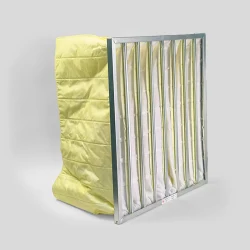How Non-Woven Air Purifier Pocket Filters Work
2024-06-21
A non-woven air purifier pocket filter is a type of filter used in HVAC (Heating, Ventilation, and Air Conditioning) systems and air purifiers to remove airborne particles and improve indoor air quality. Here’s an overview of what a non-woven air purifier pocket filter is, how it works, its benefits, and typical applications:
Description and Composition:
1. Non-Woven Material:
- The filter media is typically made from synthetic fibers such as polypropylene or polyester.
- Non-woven materials are engineered to have a porous structure that allows air to pass through while capturing particles.
2. Pocket Design:
- The filter is constructed with multiple layers of non-woven fabric arranged in a pocket-like structure.
- This design increases the surface area available for air filtration, enhancing the filter's efficiency.
3. Filtration Efficiency:
- Non-woven filters are designed to capture a wide range of airborne contaminants, including dust, pollen, pet dander, mold spores, and other particulate matter.
How Non-Woven Air Purifier Pocket Filters Work:
1. Mechanical Filtration:
- As air passes through the filter, particles are trapped within the fibers of the non-woven material.
- The porous structure of the filter media allows smaller particles to be captured as they try to pass through the fibers.
2. High Surface Area:
- The pocket design increases the surface area of the filter, maximizing contact between the air and the filter media.
- This enhances filtration efficiency and extends the lifespan of the filter before replacement is needed.
Benefits of Non-Woven Air Purifier Pocket Filters:
1. Effective Particle Removal:
- They effectively capture airborne particles, improving indoor air quality by reducing allergens and pollutants.
2. Low Resistance to Airflow:
- Non-woven materials typically offer low resistance to airflow, allowing HVAC systems to operate efficiently without significant pressure drop.
3. Longevity:
- Pocket filters have a larger surface area compared to flat filters, which can extend their service life and reduce maintenance frequency.
4. Versatility:
- Suitable for various HVAC and air purification applications, including residential, commercial, and industrial settings.
5. Compatibility:
- Compatible with different types of air handling units, air purifiers, and HVAC systems, providing flexibility in installation and replacement.
Typical Applications:
1. Residential HVAC Systems:
- Used in central air conditioning systems and furnaces to improve indoor air quality for homeowners.
2. Commercial Buildings:
- Installed in office buildings, schools, hospitals, and retail spaces to maintain clean and healthy indoor environments.
3. Industrial Settings:
- Applied in manufacturing facilities, warehouses, and cleanrooms to control airborne contaminants and maintain process integrity.
4. Air Purifiers:
- Utilized in standalone air purifiers to remove particles and allergens from indoor spaces, benefiting individuals with allergies and respiratory conditions.
Considerations for Selection:
1. Filtration Efficiency Rating:
- Choose a filter with a suitable MERV (Minimum Efficiency Reporting Value) rating or HEPA (High Efficiency Particulate Air) classification based on air quality requirements.
2. Filter Size and Dimensions:
- Ensure compatibility with the dimensions and specifications of the HVAC system or air purifier.
3. Replacement Schedule:
- Follow manufacturer recommendations for replacing filters to maintain optimal performance and efficiency.
4. Environmental Impact:
- Consider eco-friendly options or filters with recyclable materials to reduce environmental footprint.
In summary, non-woven air purifier pocket filters play a crucial role in HVAC systems and air purification devices by effectively capturing airborne particles and improving indoor air quality. Their design, filtration efficiency, and versatility make them suitable for a wide range of residential, commercial, and industrial applications where clean and healthy indoor environments are essential.



